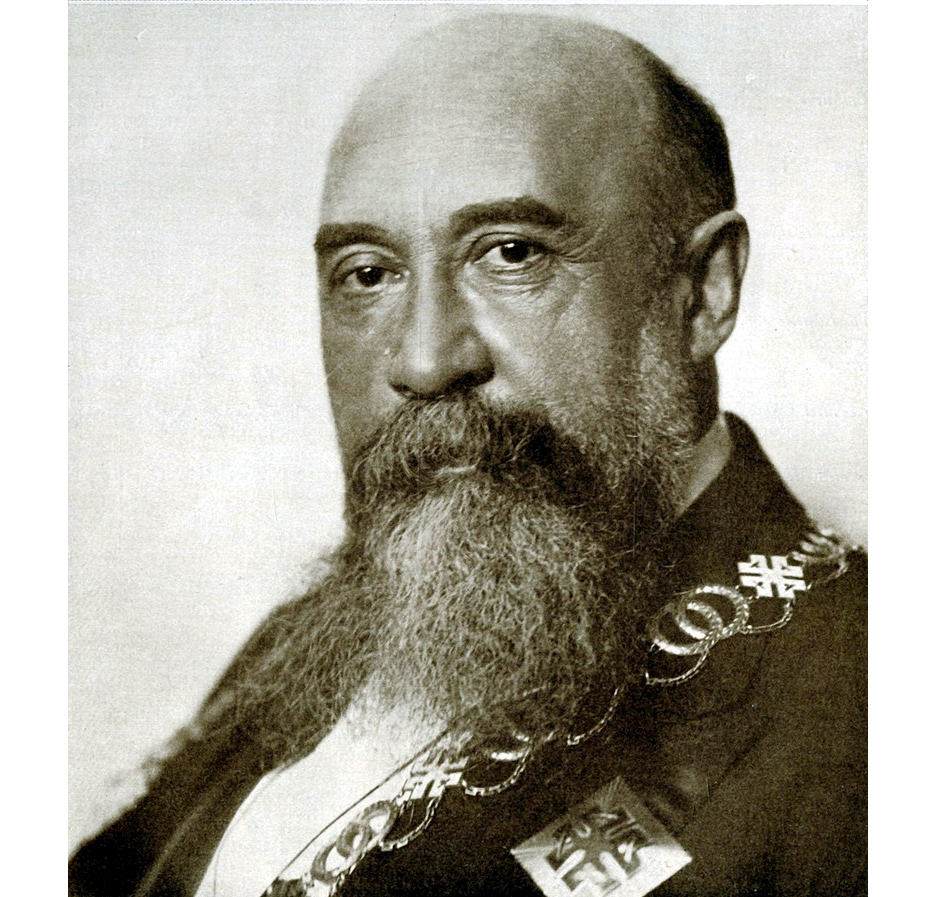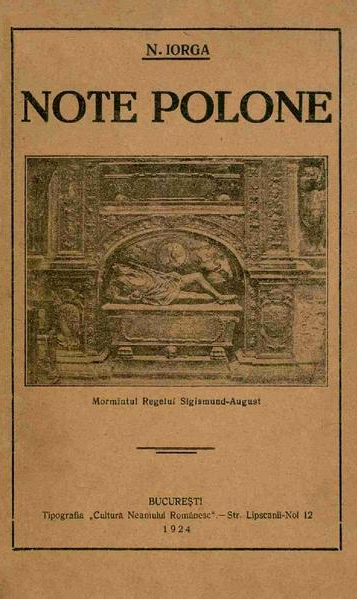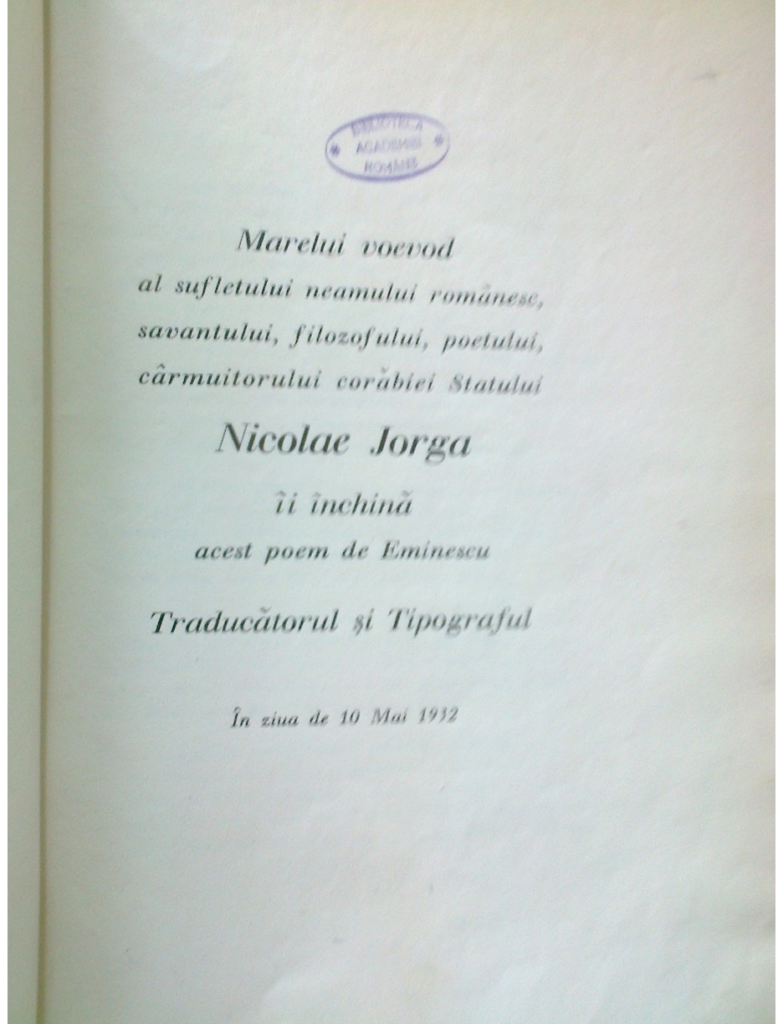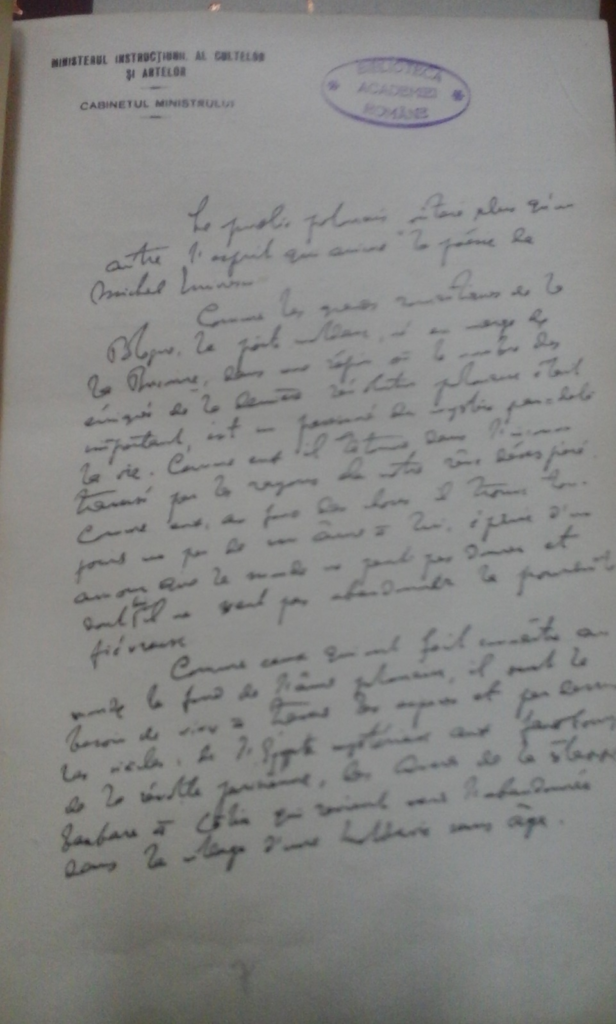COMMEMORATING 150 YEARS FROM NICOLAE IORGA’S, BIRTH A TRUE LITERARY HISTORIAN AND EXPERT IN THE FIELD OF COMPARATIVE HISTORY
Author: Nicolae MAREȘ
Abstract: In the new historical context after the Great Union and the regain of state independence by Poland, Nicolae Iorga will establish the most fruitful Romanian-Polish scientific collaboration relations, and the results of efforts in this direction have not stopped coming. For the prestige he enjoyed in the world, in 1923, the Romanian historian was to be chosen among honorary members of the Academy of Science in Krakow. The Romanian academician will be invited by the Polish state in June 1924 to be awarded the high distinction. The well-known speaker held three conferences under the dome of the old Jagiellonian University. One about Italian artists in the Romanian Lands and in Poland, the second about the life and creation of Eminescu, the third about Romania with the presentation on the slides of some autochrome colour images.
Keywords: Poland, independence, University of Krakòw, Moldova, historical relations, Romania, Great Union, self-determination of nations
The great Romanian historian and creator not only knew very well the Polish history and culture, but since childhood he showed special love and appreciation for our neighbours in the northwest. The historian, the academician, the writer was the one who cultivated and militated like no other for the establishment of the best possible relations of knowledge and cooperation between the two countries and peoples, between their cultures.[1].
Not coincidentally, in the early 1920s, the academician sent the promising historian, P. P. Panaitescu, as a Romanian language lecturer at the University of Krakow. Iorga’s close disciple, he simply “cleared” the Polish archives in the old capital of the Jagiellonians.[2]
In Romania, the speaker mentioned it less often, but in Poland, he did it every time he had the opportunity, that his first history teacher, while attending high school in Botosani, was a Polish revolutionary teacher, one of the those who participated in the military uprising of 1863, called the January uprising or powstanie styczniowe. Tokarski was his name, and he had taken refuge in Moldova with many other Poles, to live and work alongside the Romanians. That high school teacher had travelled the same path beaten many decades ago by his predecessors, starting in the 18th century, when the call was still in vogue on Polish soil: Kto kocha ojczyznę niech jedzie na Wołoszczyznine/ Who loves his homeland to flee to Wallachia!
For your freedom and ours
I do not know if the great historian he become later knew this rhyming bunch, which had even entered Polish paremiology and in which Moldova and Muntenia were listed as saving targets in the face of Poland’s oppressors, especially the Muscovites. Because the stackers were none other than the Russians, Prussians or Austrians, all twinned together so as not to lose the prey tendered in 1772, 1793 and 1795. The Poles left their homelands in great need to train in the West and return better tempered and prepared for the liberation of their country.

In the torments and in the minds of the representatives of the Great Polish Emigration from everywhere: Mickiewicz, Lelewel, Czartoryski etc., the idea was born to fight for the liberation of their country and other nations that were rising for liberation from foreign oppression. The Romanian Pasoptists learned from the Poles what it means and how to apply the call: For your freedom and ours – fraternizing on the barricades of the Revolution of 1846 and 1848 to achieve this goal.
An important English historian, Normad Davies, found the homeland of these Polish revolutionaries the name of God’s Playground.[3] The Romanians did not dare as much as they dreamed and wanted: the Pasoptists wanted to see in them an ally against common subjugation: Russians and Austrians. Bălcescu stubbornly tried to lure the Polish revolutionaries to his side, including against the cruel exploitation of Hungary, trying to bring Bem and Dembinski closer in 1849 to support the cause of Romanianness.[4]
Looking more closely, we find that Iorga’s first teacher of history was that fighter who instilled in him a special love for his country and the Polish past. When the dawn of Poland’s liberation appeared towards the end of the First World War, even if they seemed quite nebulous, Iorga wrote and published in the Neamul Românesc the most beautiful hymn to the Polish flag / white-red /, raised by the Polish military called to weapons under tsarist command and which were among the Russian troops stationed in Galati. There is no similar text, so ardent in the journalism of other countries.[5] A real hymn to the Polish flag and Polish manhood in battle:
In Galaţi, the Polish flag of the white eagle was raised, which overcame the Teutonic cross so many times and guarded the entire East – both the Russian and the Romanian – from the German conquest. He fluttered proudly and freely, enthusiastically acclaimed by the noble soldiers in arms with eyes full of tears at the sight of their country coming out of the grave. And from the beginning he found a companion in the flag of Romania, who also struggled and still struggles on so many fields of martyrdom of the people he portrayed. Side by side in fraternal closeness, they announced to us a guarantee of the future for our tormented and sacrificed people: a neighbour to whom we are connected by so many older traditions, in addition to essential elements in the very soul of these two nations, a gentle feeling, of a devotion to the ideal, of a deep contempt for the overwhelming force of raw matter.
We know this Polish flag. He was long hidden in our houses, when, at the end of a miserable revolution, he was pursued with the last bloody remains of his defenders, to whom we opened wide, with all our risk, which was not small, the gates of brotherly hospitality. He stood between four Romanian walls, sacredly guarded for the great day that was to come, and the Poles, who in the museum in Switzerland have as well, between the faces of their warriors and martyrs, the disinterested protective face of Prince Alexandru Ioan Cuza, know it as well.
Iorga about Eminescu at the Jagiellonian University
In the new historical context after the Great Union and the regain of state independence by Poland, Nicolae Iorga will establish the most fruitful Romanian-Polish scientific collaboration relations, and the results of the efforts made in this direction have not stopped coming. For the prestige he enjoyed in the world, in 1923, the Romanian historian was to be chosen among honorary members of the Academy of Science in Krakow. The Romanian academician will be invited by the Polish state in June 1924 to be awarded the high distinction. The well-known speaker held three conferences under the dome of the old Jagiellonian University. One about Italian artists in the Romanian Lands and in Poland, the second about the life and creation of Eminescu, the third about Romania with the presentation on the slides of some autochrome colour images. In the volume Memorii, he will write succinctly: A numerous audience, very understanding and warm[6].
The exact content of neither one of the speeches is known. We would be curious to know if he had exposed any of his theses on Eminescu such as the integral expression of the Romanian soul, or the one regarding the achievement of the most extensive synthesis made by any Romanian soul.
One year later, the scholar from Vălenii de Munte will publish, in the Library for All collection, his notes from this trip, under the title Note polone – a cordial volume in the form of notes and reports on what reborn Poland meant. In the memoirs, we find the evocation of the meeting with the Marshal of Poland, Józef Piłsudski, in the Miluszin mansion in Sulejówek. All chapters of history… Of cordial history.

It was a happy coincidence that one of the leading poets of the interwar period, the patriotic Transylvanian, Aron Cotruș, became press attaché in Warsaw, exactly when Iorga held the position of prime minister. Together with his Polish confrere, Emil Zegadłowicz, the two agreed to translate Romanian lyric poetry into Polish, so after the publication of the first anthology of Romanian poetry: Teme românești, published / in 1931 / and the poem Împărat și proletar, bibliophile edition, printed 1932, dedicated to the “Grand Duke of the Romanian national soul, the scientist, the philosopher, the poet, the ruler of the State’s ship”, a leader whom Zegadlowicz had met a year before at the Summer University in Vălenii de Munte. Cotruș will personally accompany him, also taking him to the poet’s grave, in Bellu Cemetery from Bucharest.

The dedication in Romanian from the bibliophile edition of the poem Împărat și proletar
LESS KNOWN
Eminescu’s first poems translated into Mickiewicz’s native language were prefaced by Iorga
In June 1933, thanks to the efforts of the Polish writer and translator, Emil Zegadlowicz, the third anthology appeared. It contained 26 of the most important poems in Eminescuțs creation, 23 of them seeing the light of print in Polish for the first time.
We do not exclude the possibility that in Vălenii de Munte, on the Teleajen Valley, the idea that the Romanian historian, scientist, poet and playwright should preface the volume was born. The contents of the anthology included the poems: Że umrzeć mam (Ode), Ponad szczytami (Peste vârfuri), Las (Ce, te legeni…), Diana, Do gwiazdy (La steaua), Przez fale przez zawieje (Dintre sute de catarge), Jutrem życia dzień się zwiększa (Cu mâine zilele-ți-adaugi), Północ (Se bate miezul nopții), Testament (Mai am un singur dor), Kamadewa, Wszystie ptaki w borze (La mijloc de codru des), Jezioro (Lacul), Jaskółki (De ce nu vii), Gdy gałęź w okno me uderzy (Și dacă…), Uliczka (Pe aceeși ulicioară), Jak? Co? (De-or trece anii…), Rozłączenie (Despărțire), Daleko (Departe sunt de tine), Sonnet Pierwszy (Sunt ani la mijloc), Sonet Drugi (Când însuși glasul), Gwiazda wieczorna (Luceafărul), Cesarz i proletariusz (Împărat și proletar), List I, II, III (Scrisoarea I, a II-a, a III-a), Modlitwa Daka (Rugăciunea unui dac), all in the great grace transposition of the Wadowic poet.[7]
To emphasize how great the surprise of Polish critics and readers was, I reproduce only a few words from a review published in a Warsaw daily, signed by St. Szpotański and in which it is said: a translation from Eminescu places Zegadlowicz on the highest level of poetic value.
The preface sent by the Romanian Prime Minister for publication to Emil Zegadłowicz, through Aron Cotruș, appeared together with Caragiale’s Nirvana. Predoslovia was written by Nicolae Iorga, in French, with the handwritten content below:

Here is the text not published in Romania so far:
Le public polonais goûtera plus qu’un autre l’esprit qui anime la poésie de Michel Eminescu.
Comme les grands romantiques de la Pologne, le poète moldave, né en marge de la Bucovine, dans une région où le nombre des émigrés de la dernière révolution polonaise était important, est un passionné du mystère par-delà la vie. Comme eux, il tâtonne dans l’inconnu traversé par les rayons de notre rêve désespéré. Comme eux, au fond des choses il trouve toujours un peu de son âme à lui, éprise d’un amour que le monde ne peut pas donner et dont lui, il ne veut pas abandonner la poursuite fiévreuse.
Comme ceux qui ont fait connaître au monde le fond de l’âme polonaise, il sent le besoin de vivre à travers les espaces et par-dessus les siècles: de l’Egypte mystérieuse aux faubourgs de la révolte parisienne, des Aralds de la steppe barbare à Calin qui revient vers l’abandonnée dans le village d’une Moldavie sans âge. Comme ceux qui chez vous se sont montrés fiers d’un passé de lutte et de triomphes, il se plaît à célébrer les cliquetis de lances des guerres du vieux Mircea contre les Turcs du XIVe siècle et un poème épique qu’il a négligé de terminer au cours d’une vie banale et malheureuse pose la figure légendaire du créateur de la patrie moldave.
Ne se croît-on pas dans la mystique polonaise lorsque le héros de son roman Le Pauvre Denis passe par les métamorphoses d’un Faust sans compagne, dans l’essor de son rêve insensé ?
Les nations se rapprochent par le travail des humbles et par les élans des esprits créateurs. Eminescu aura sans doute sa part dans cette communion d’âme entre Polonais et Roumains qu’auraient désirée nos ancêtres, souvent camarades de la bonne guerre chrétienne.
N. Iorga
The content, in today’s transposition of the writer Elena Dan, sounds like this:
The Polish public will appreciate more, than any other, the spirit that animates Mihai Eminescu’s poetry. Like the great romantics of Poland, the Moldavian poet, born on the borders of Bukovina, in a region where the number of refugees of the last Polish revolution was quite high, is passionate about the mysteries of the afterlife. Like them, he probes into the unknown crossed by the rays of our hopeless dream. Like them, the poet always finds in the depths of things something of his soul contained in a love that the world could not give him and whose ardent pursuit he did not want to abandon.
Like them, who made known to the world the depths of the Polish soul, he feels the need to live beyond spaces and centuries: from the mysterious Egypt to the suburbs of the Parisian revolt, from the Erolds of the barbarian steppe to Calin, who returns to the woman he had abandoned in a village long time ago in Moldova.
Like all those who, in Poland, were proud of a past of battles and victories, he also likes to celebrate the rattle of spears in the wars waged by Mircea the Elder against the Turks in the fourteenth century, and a poem that the legendary face of the founder of the Moldovan country remains unfinished.
Do we not feel in full Polish mysticism when the heroes of his novel Poor Dionysus go through the metamorphoses of a Faust without a consort, in the unfolding of his reckless dream?
Nations come closer to each other through the toil of the lowly and the zeal of the creative spirits. Eminescu undoubtedly has his share of contribution to this communion of soul between Poles and Romanians, a communion that our ancestors will have dreamed of, who met more than once as comrades in the beautiful struggle for Christianity.
N. Iorga
We notice how, in a few dense sentences, Iorga did something more than an evocation of Eminescu’s lyricism; he made a historical foray full of obvious allusions to the Poles, he also gave a real lesson in literary comparativism that few critics of the time could have done so accurately and competently. Something impossible nowadays. The poet Iorga compares the Eminescu spirit with that of the great Polish Romantics, emphasizing that it probes into the unknown crossed by the rays of our hopeless dream. And he finds: in the depths of things something of his soul contained in a love that the world could not give him and whose ardent pursuit he did not want to abandon.
The scientist also points out that Eminescu, the Romanian poet, like the Polish poets, who so masterfully depicted for the wide worlds the depths of the Polish soul, and the author of Luceafărul, Ode or Glossa felt the need to: live beyond spaces and centuries: to the mysterious Egypt to the suburbs of the Parisian revolt, from the Eralds of the barbarian steppe to Călin, who returns to the woman he had abandoned in a village of a Moldovan from beyond. This is how Iorga did not forget the appearance in the previous year of the poem Împărat și proletar; recalling that Polish poets illustrated the glorious past of the forerunners, noting that Eminescu also liked: to celebrate the rattle of spears in the wars waged by Mircea the Elder against the Turks in the fourteenth century. Obvious allusion to the poem Scrisoarea a III-a – probably noticed by the preface in the content of the anthology composed by Zegadłowicz.
The author of 1003 works and also over ten thousand contributions to universal history and culture, the encyclopaedist writer recalls, like the great chronicler Jan Długosz six centuries ago, that our ancestors met more than once: as comrades in the beautiful struggle for Christianity.
From what position did Iorga speak this time, that of a historian of religions or as a contemporary of ours now, in the third millennium?
Nicolae Mareș, PhD, Doctor Honoris Causa of the “1 Decembrie” University of Alba-Iulia; former career diplomat for 40 years, writer – over 80 volumes of poetry, aphorisms, history of culture and literature, literary comparativism, history of diplomacy and international diplomatic relations. Author of over 600 contributions in the field of history of literature, literary comparisons, Romanian-Polish relations over the centuries, diplomacy, hospitality, etc. He published almost 20 books on the life and work of Pope John Paul II. For his tireless work in writing about St. John Paul II, the Holy Father, Pope Francis awarded him, in August 2015, one of the most important distinctions conferred by the Vatican: Pro Ecclesia et Pontifice – order established by Leo XIII in 1888.
[1] Nicolae Mareș, Raporturi româno-polone de-a lungul secolelor, pp. 276-333, 2nd edition added and revised, TipoMoldova Publishing House, Iași, 2016.
[2] According to doctoral thesis Influența polonă în opera și personalitatea cronicarilor Grigore Ureche și Miron Costin, Cultura Națională, Bucharest, 1925, dedicated to Prof. Stanisław Wędkiewicz.
[3] Norman Davies, History of Poland – God’s Playground, Polirom Publishing House, 2014.
[4] Nicolae Mareș, Raporturile lui Bălcescu cu exilul și revoluționarii polonezi în anii 1848-1849, în Istorie – Diplomație, Essays, Vol. II, TipoMoldova, pp. 37-59 and 61-81.
[5] Nicolae Mareș, op. cit., p. 278.
[6] Nicolae Iorga, Memorii, vol. 3, June 19, 1924, p. 162.
[7] Michal Eminescu, Poezje / Poezii, Przeklad Emil Zegadlowicz, Poznan, 1933.
